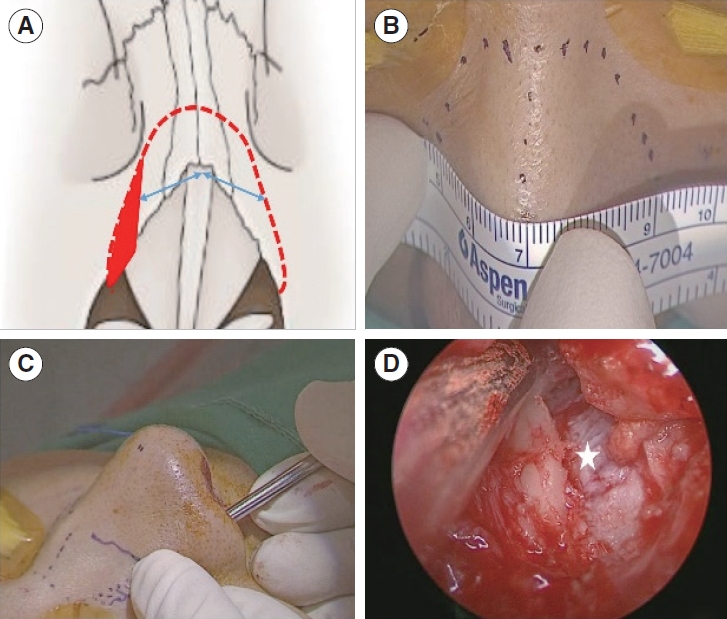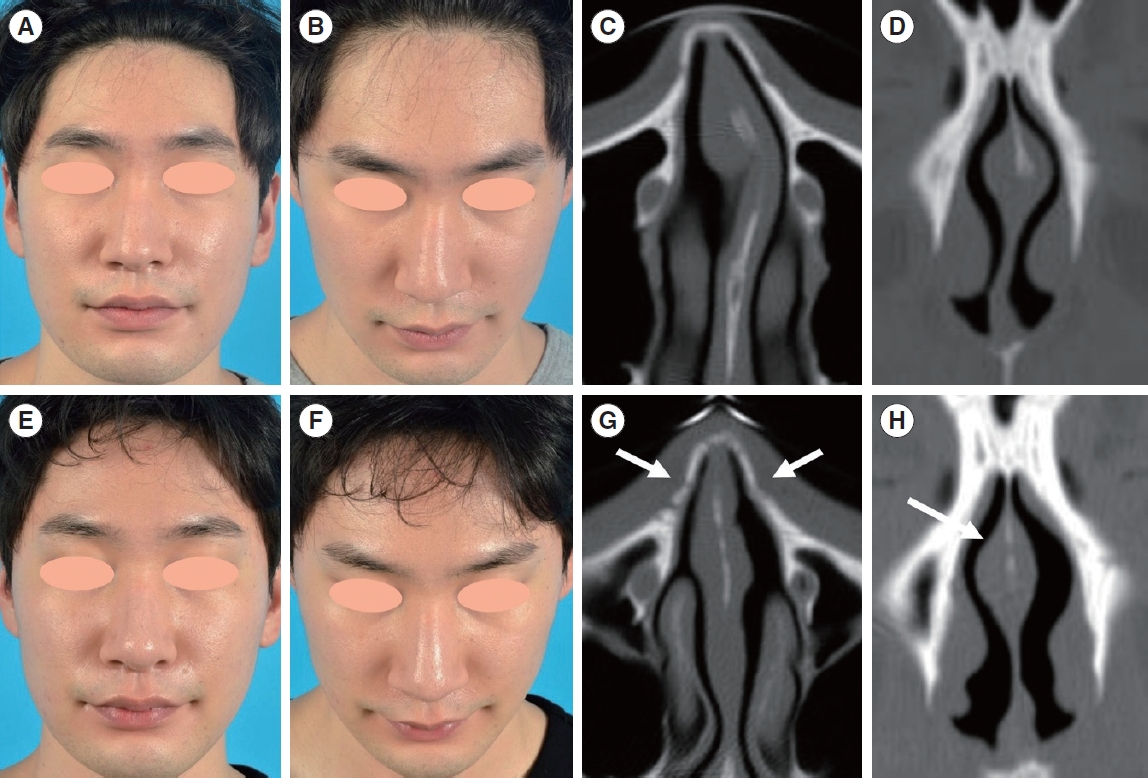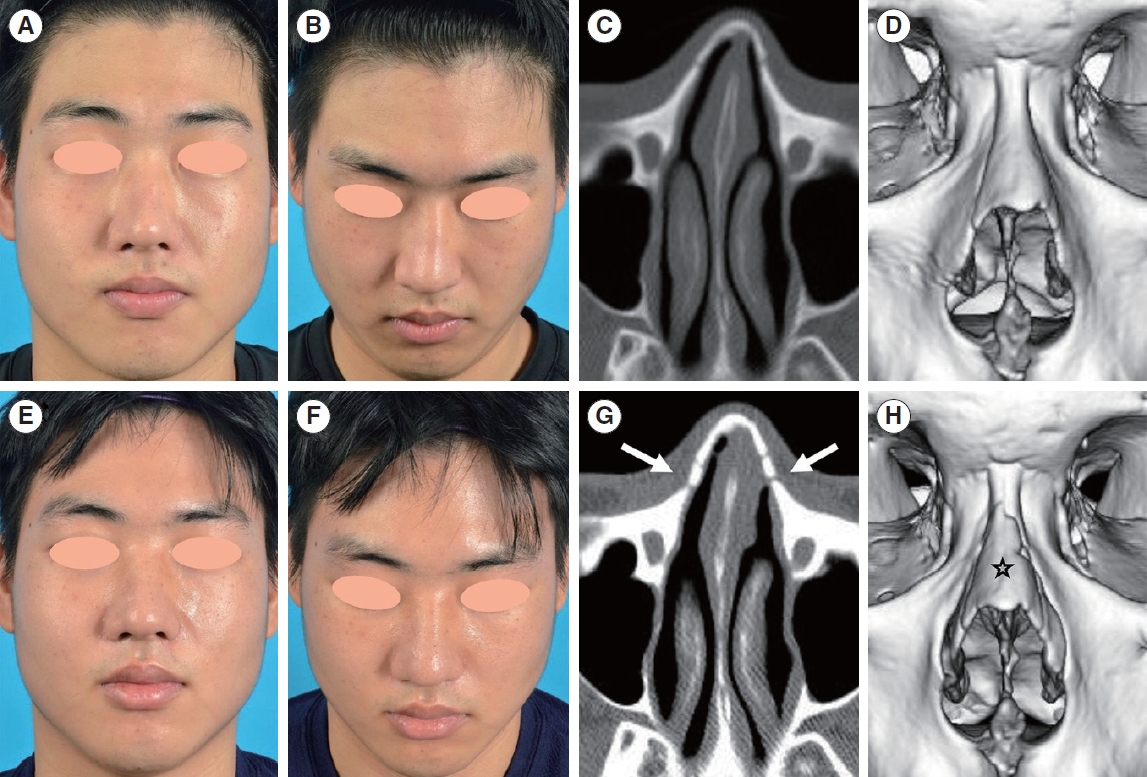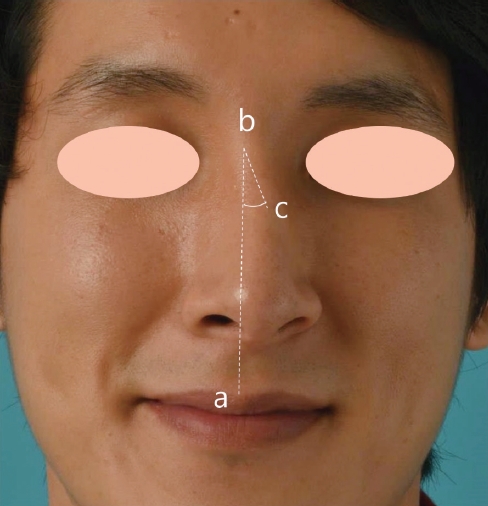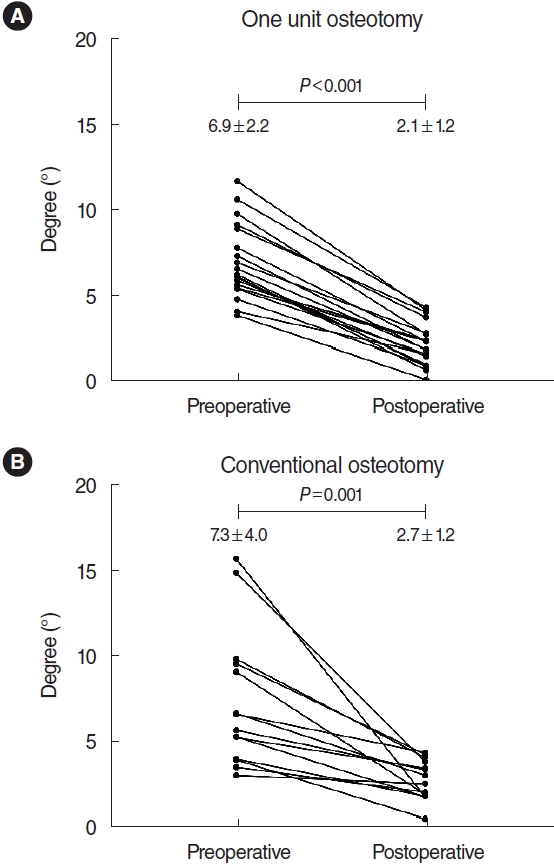Clin Exp Otorhinolaryngol.
2023 Feb;16(1):59-66. 10.21053/ceo.2022.01095.
One-Unit Osteotomy to Correct Deviated Bony Dorsum
- Affiliations
-
- 1Department of Otorhinolaryngology-Head and Neck Surgery, Kyungpook National University Chilgok Hospital, School of Medicine, Kyungpook National University, Daegu, Korea
- 2Department of Otorhinolaryngology-Head and Neck Surgery, Samsung Medical Center, Sungkyunkwan University School of Medicine, Seoul, Korea
- KMID: 2539769
- DOI: http://doi.org/10.21053/ceo.2022.01095
Abstract
Objectives
. A crooked nose is frequently caused by nasal bony vault deviation, and proper management of the bony vault is an integral part of rhinoplasty. Conventional osteotomy to correct a deviated nose favors simultaneous medial and lateral osteotomies, which allows the free independent movement of each nasal bone. However, patient satisfaction with deviated nose surgery is sometimes low. In the present study, we introduce a one-unit osteotomy procedure that combines bilateral and root osteotomies with unilateral triangular bony wedge resection to allow symmetry of both nasal bones.
Methods
. Twenty consecutive patients who presented with bony vault deviation and underwent one-unit osteotomy were enrolled in this retrospective single-center study. The Nasal Obstruction Symptom Evaluation (NOSE) questionnaire was used to evaluate each patient’s functional outcome. The angle of bony vault deviation before and after one-unit osteotomy was measured using a protractor and compared with the results of 14 patients who had undergone conventional osteotomy. The improvement in dorsal deviation was evaluated using facial photography preoperatively and 3 months postoperatively.
Results
. NOSE values improved from 8.4±6.4 to 4.1±4.2 (P =0.021). The angle of bony vault deviation improved from 6.9°±2.2° to 2.1°±1.2° (P <0.001) in one-unit osteotomy and from 7.3°±4.0° to 2.7°±1.2° (P =0.001) in conventional osteotomy. The preoperative deviation angle improved by 70.3% in one-unit osteotomy compared with 56.6% in conventional osteotomy, which was a significant difference (P =0.033). The mean grade of the postoperative esthetic outcomes for the remaining deviation was 1.6±0.5, which was similar to that in the conventional osteotomy group.
Conclusion
. One-unit osteotomy is a relatively simple procedure that balances the width of both lateral walls by removing excessive bony fragments from the wider bony wall and providing better structural integrity. This technique improves functional outcomes and has equivalent esthetic results to those of the traditional procedure.
Keyword
Figure
Reference
-
1. Jameson JJ, Perry AD, Ritter EF. High septal osteotomy in rhinoplasty for the deviated nose. Ann Plast Surg. 2006; Jan. 56(1):40–5.
Article2. Jang YJ, Wang JH, Sinha V, Lee BJ. Percutaneous root osteotomy for correction of the deviated nose. Am J Rhinol. 2007; Jul-Aug. 21(4):515–9.
Article3. Gola R. Functional and esthetic rhinoplasty. Aesthetic Plast Surg. 2003; Sep-Oct. 27(5):390–6.
Article4. Jin HR, Won TB. Rhinoplasty in the Asian patient. Clin Plast Surg. 2016; Jan. 43(1):265–79.
Article5. Saban Y, Daniel RK, Polselli R, Trapasso M, Palhazi P. Dorsal preservation: the push down technique reassessed. Aesthet Surg J. 2018; Feb. 38(2):117–31.
Article6. Kang JM, Nam ME, Dhong HJ, Kim HY, Chung SK, Kim JH. Modified mattress suturing technique for correcting the septal high dorsal deviation around the keystone area. Am J Rhinol Allergy. 2012; May-Jun. 26(3):227–32.
Article7. Shin J, Cho J, Hong SD, Jung YG, Ryu G, Kim HY. Internal nasal valve modification via correction of high dorsal deviation using a modified mattress suture technique. J Clin Med. 2022; Oct. 11(19):5888.
Article8. Ryu G, Seo MY, Lee KE, Hong SD, Chung SK, Dhong HJ, et al. Triangular resection of the upper lateral cartilage for middle vault deviation. Clin Exp Otorhinolaryngol. 2018; Dec. 11(4):275–80.
Article9. Okur E, Yildirim I, Aydogan B, Akif Kilic M. Outcome of surgery for crooked nose: an objective method of evaluation. Aesthetic Plast Surg. 2004; Jul-Aug. 28(4):203–7.
Article10. Jin HR, Lee JY, Shin SO, Choi YS, Lee DW. Key maneuvers for successful correction of a deviated nose in Asians. Am J Rhinol. 2006; Nov-Dec. 20(6):609–14.
Article11. Choi JW, Kim MJ, Jeong WS. One-piece nasal osteotomy for the correction of a centrally deviated nose. Aesthetic Plast Surg. 2018; Dec. 42(6):1625–34.
Article12. Chatrath P, De Cordova J, Nouraei SA, Ahmed J, Saleh HA. Objective assessment of facial asymmetry in rhinoplasty patients. Arch Facial Plast Surg. 2007; May-Jun. 9(3):184–7.
Article13. Yi JS, Jang YJ. Frequency and characteristics of facial asymmetry in patients with deviated noses. JAMA Facial Plast Surg. 2015; Jul-Aug. 17(4):265–9.
Article14. Kosins AM, Daniel RK, Nguyen DP. Rhinoplasty: the asymmetric crooked nose-an overview. Facial Plast Surg. 2016; Aug. 32(4):361–73.
Article15. VanKoevering KK, Rosko AJ, Moyer JS. Osteotomies demystified. Facial Plast Surg Clin North Am. 2017; May. 25(2):201–10.
Article16. Sykes JM, Kim JE, Shaye D, Boccieri A. The importance of the nasal septum in the deviated nose. Facial Plast Surg. 2011; Oct. 27(5):413–21.
Article17. Patel PN, Abdelwahab M, Most SP. A review and modification of dorsal preservation rhinoplasty techniques. Facial Plast Surg Aesthet Med. 2020; Mar-Apr. 22(2):71–9.
Article18. Choi JE, Noh YS, Koh SM, Shin JB, Lee KE, Jung YG, et al. The potential esthetic effect of endonasal septoplasty on the cartilaginous dorsum in Asian population. Facial Plast Surg Aesthet Med. 2021; Jan-Feb. 23(1):42–8.
Article


